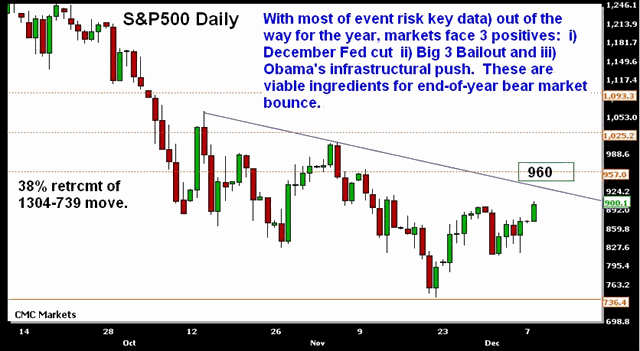More Risk Appetite as Stimuli Gone Wild
Global equities, high yielding currencies and commodities pursue their rallying ways in US trading as stimulus hysteria grips the worlds leading economies. President- elect Obama's resounding push for an infrastructure-based stimulus package of more than $700 bln and a possible Congressional vote over as many as 3 bridge loans to US automakers as early as Tuesday. Obamas stimulus drive is particularly underscored by relegating federal budget deficit concerns to the bottom of economic priorities. These announcements have proven to be a vital stepping stone for a much-anticipated bear market leap. Buying began to emerge in late NY Friday trading before news of a Detroit bailout plan or an Obama stimulus hit the wires. Fiscal stimulus announcements were also made across Continental Europe and India, while China could follow suit income tax cuts.
FX markets display the usual pattern seen in rising equity markets, with CAD, AUD, NZD and GBP flexing their higher yielding muscle against JPY, USD, CHF and EUR. The USD and JPY are the biggest losers as they bleed speculative flows into commodity currencies as well as GBP. Gold rallies over $20 off Fridays $741 low but has yet to face substantial pressure at the $805.

The S&P chart below shows the technical version of the bulls failed attempts for any bull market rally. But unlike the past 9 weeks, the remainder of the calendar year will be relatively devoid of event risk (potentially negative events such as major econ data and corporate earnings), clearing the way for a flurry of potentially market-friendly developments from Washington (bridge loans to Detroit) and further details on Obamas +$70 bln stimulus. The 920 target may prove less elusive, a break of which will face more considerable pressure at the 960 resistance.
GBPUSD continues to offer unique volatility thanks to short-term spec. orders from Treasuries, bank desks and CTAs seeking to improve trading revenues on the rules of risk-driven market flows. Despite the bigger than expected 3.3% decline in UK Nov PPI and remarks from BoEs John Give indicating zero interest rates as a possibility, cable remains largely driven by the intraday flows in equities. UK CPI wont be out until next week, thus, the lack fo major data releases from US and UK seen offering prolonged room from for speculative upside. Short term range underpinned by $1.46 support and $1.4890 resistance, Intermediate gains capped at $1.4890 and $1.5030.









No, I wrote yesterday " I warned CMC clients yesterday in the event of a 75-bp cut, CAD downside is expected to broaden, with USDCAD likely to overshoot to as high as 1.2720-40 before a retreat towards 1.2660s is guided by rallying equities". That means that USDCAD would have a kneejerk reaction higher (CAD lower) towards 1.2740s then drops back down (CAD goes back up) and that is what happened. It is hard to foresee USDCAD regaining 1.30 in the short0term, unless of course stocks drop another 4 to 5%.
Ashraf
See below, that means usd/cad is in uptrend, to break 1.3 eventually to go beyond? Pls advise. Have a happy holiday.
-----------------------
December 10, 2008 08:37: I warned CMC clients yesterday in the event of a 75-bp cut, CAD downside is expected to broaden, with USDCAD likely to overshoot to as high as 1.2720-40 before a retreat towards 1.2660s is guided by rallying equities. USDCAD topped out at 1.2740s before retreating below 1.26. Current decline in risk aversion and modest rally in commodities may extend losses in USDCAD towards 1.2520s, leaving resistance intact at 1.2720.
Simply put, quantitative easing means central banks willl pump up liquidity with the goal of targetting the quantity of money rather than its price (interest rates). Looks like the Fed is already doing it.This is generally negative for currencies as a whole and helpful for gold in the long run. At times of short term recoveries in stocks, USD and JPY are seen as the big losers while CAD, AUD and NZD are preferred. Note how the JPY is holding quite firm, keeping all JPY crosses under pressure.
Ashraf